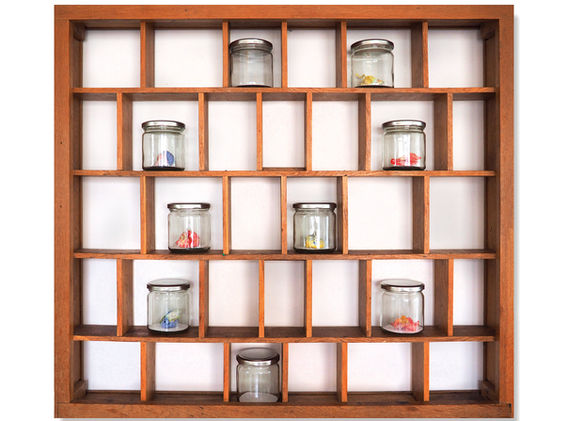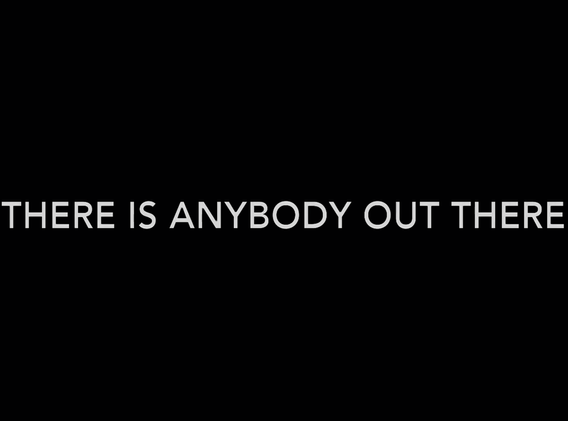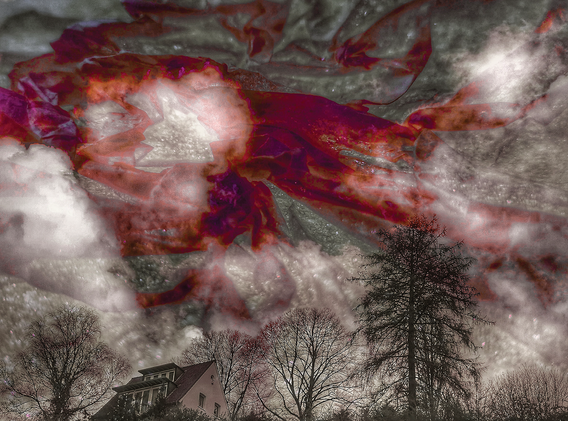Obst | Annette to the power of 10
Annette's lungs
Since Annette von Droste-Hülshoff was born too early, she suffered from the consequences of an undeveloped lung maturity. Shortness of breath, frequent coughing, a feeling of tightness in the chest and general weakness were her constant companions. She probably died of severe pneumonia. The object made of cotton wool, thread and music paper, mounted on linen that is more than a hundred years old, refers to the damaged air sacs in the lungs and the associated limitations, which meant that the poet had to spend much of her life in bed. Nevertheless, at times she was even able to perform singing.
Through Annette's eyes: ten small pieces of grass
Another consequence of being born too early was her nearsightedness. She had to get very close to things to see them when she didn't have her lorgnette to hand. In my work, I tried to put myself in such a situation and to understand what and how she could have viewed and perceived the things in nature that she enthusiastically explored – in addition to writing. For this I chose ten, ten by ten centimeter areas on the lawn in our garden, on which I placed the plexiglass panes in order to draw what I perceived one-to-one. Since a mimetic depiction – as Albrecht Dürer tried with a piece of grass, for example – is not possible in this way, abstract drawings were created. In this respect, the works that were created in this way can be understood both as fictitious securing of evidence and as aesthetic research.
Annette's finds 4.0
Not only in the area around Gut Rödinghausen, in the Hönnetal, did Annette like to be out and about with her geologist's hammer, always on the lookout for special stones or any treasures that might be hidden in them. What will their successors find in the future? Which life forms will have disappeared by then, which new ones will populate the earth? And which of these will future amateur archaeologists perhaps discover, which of the finds will perceive as treasures?
On the one hand, the fictitious finds and the partly empty glasses are reminiscent of the amateur geologist Annette von Droste-
Hülshoff and on the other hand invite you to fantasize about
Answers to these questions - To find a completely different treasure, namely the treasure of creativity within yourself.
Annette's creative cells
Creativity is expressed in many phenomena. The creative, literary work of Annette von Droste-Hülshoff is clearly one of them, because thinking and writing are creative processes. The processes in the brain, invisible to the human eye, whose cells are in constant motion and thereby form new connections, which lead to a verse being created, a hand moving its fingers in such a way that a story can be written, are fascinating me. My digital drawings and animations are not about a realistic representation of these processes, but about their transformation into a creative form that makes the fantastic in the neurobiological, transformative, plastic processes visible.
Annette's wanderlust - The hybrid island
Annette would have liked to travel more, certainly not only out of a thirst for knowledge and a thirst for adventure, but also to escape the social constraints to which she was subject and which prevented her from leading a freer life. Since she was a woman and not in good health, she was not allowed to travel long distances. So she traveled in her imagination, keeping both feet on the ground of reality. She had the gift of perceiving the mystical and magical parallel to reality and weaving them into her poems. She is therefore considered by many to be a pioneer of magical realism. I had a similar experience during the spring 2021 lockdown. I wasn't able to travel long distances, but I could go hiking in the Hönnetal and travel to fantastic places in my imagination. My digital image overlays, all of which were created on a cell phone, consist of snapshots of the area around Menden, which I overlaid with photos of fictitious landscapes made of tissue paper and edited until magical places emerged: The »Hybrid Islands«.
Annette's lines
As I understand Annette, she has consistently pursued her "line", namely her plan to become a poet - and this against all possible resistance. Inevitably she had to deviate from the lines and role models she had drawn up. Sometimes voluntarily, sometimes involuntarily, she consequently crossed social, personal and literary »red lines«. From my point of view she was highly intelligent and courageous, but at the same time not free from doubts. Rather, she will have been accompanied »without a period and comma« by an inner dialogue of doubt, conducted with herself and the internalized voices of her parents, siblings, teachers, friends and other contemporaries who were important to her. She probably didn't actually write down everything she wanted to write. Much remains unsaid, pleasant, unpleasant, maybe even naughty? Annette was only 52 years old. What and how would she have written if she could have lived longer?
Annette's tears
"My outer eye sank, my inner one was opened up," Annette wrote in a poem. I think Annette experienced a lot of pain in her life. Against all pain and adversity, however, she asserted herself in courageous, meditative self-reflections, which her, albeit mostly only posthumously, were gilded with fame. For the golden word sculptures I used quotes from various poems by Annette.
Annette's rain
Rain was not uncommon in the Münsterland at that time. It can therefore be assumed that it often rained when Annette sat at her desk to write down verses. In a figurative sense, these later became a rain, a fertile rain of words, which in particular inspires many women writers to this day and for whom she was both a role model and a pioneer with her consistent pursuit of her literary ambitions. The rain of words in the installation consists of a completely cut up edition of the author's complete works. The red markings on the "dripping words" may encourage you to take a closer look at them and to create your own poetic lines from them, which is anything but easy.
As an example of a contemporary poet who, like Annette, tried to put into verse what she perceived and moved, the collage accompanying the installation entitled »About Poetry« Friederike Mayröcker (1924 – 2021) to see.
Annette very presumptuous
The "social pattern" that Annette von Droste-Hülshoff seemed to have drawn out for her life from her family was clear, but it didn't suit her. She would have liked to have received more recognition for her talent and ambitions and more attention for her works during her lifetime than she was given.
Today, however, both her personality and her work radiate into the world. Her merit for German literature is undisputed. However, despite all research, it will never be possible to fully appreciate or even measure the life and person of Annette von Droste-Hülshoff. Some things will remain in the dark, such as the internals of her friendship with Amalie Hassenpflug, how exactly the intrigue surrounding Heinrich Straube came about, which writings she may have self-critically destroyed instead of publishing them - and much more.
Of course Annette
If Annette von Droste-Hülshoff were alive today, would she be active on social networks?
What would she write about and how? Would she present herself on Facebook, Instagram or TikTok? What are the stories she might post on Instagram about herself and her life, about poetry, her lovesickness, her fondness for geology and nature, for superstitions and haunted stories?
How many followers do you think she would have? The ten fictional Instagram stories not only raise the question of how far Droste is still an influencer today, but also answer with a wink that at least her person, her life and work offer enough material for it.



































































